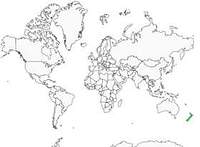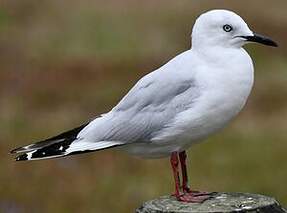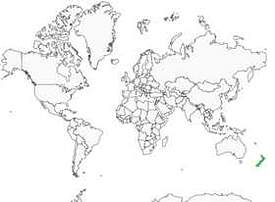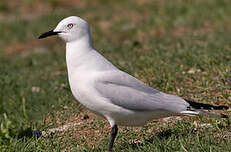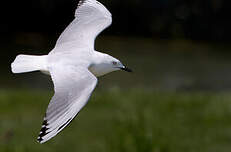Black-billed Gull
Chroicocephalus bulleri - Mouette de Buller
Identification
There are only two species of gulls in New Zealand, but they look alike. The Black-billed Gull has a thin, black beak (while the New Zealand Black-backed Gull (Larus scopulinus) has a thicker, red beak) and it is much paler than its counterpart. The upper part is of a very light grey and the wingtip is barely marked in black. The eyes of adults are light, whereas they are dark in juveniles. The species is monotypic (no subspecies).
Subspecific information monotypic species
Foreign names
- Mouette de Buller,
- Gaviota maorí,
- gaivota-de-bico-preto,
- Maorimöwe,
- maori sirály,
- Zwartsnavelmeeuw,
- Gabbiano becconero,
- svartnäbbad mås,
- Maorimåke,
- čajka jazerná,
- racek černozobý,
- Maorimåge,
- uudenseelanninlokki,
- gavina de Buller,
- mewa czarnodzioba,
- melnknābja kaija,
- Буллерова чайка,
- ハシグロカモメ,
- 新西兰黑嘴鸥,
- svartnäbbad mås,
- 紐西蘭黑嘴鷗,
Voice song and call
Habitat
Endemic to New Zealand, the Black-billed Gull breeds mostly in the interior of the South Island as well as around Rotorua in the North Island. There are few coastal colonies in the South Island. During the breeding season, it frequents mainly shorelines and islets of lakes and rivers. During the non-breedinig period, the birds disperse and it can be observed on the coasts of both islands, often in the company of the Kelp Gull. It also happily frequents flooded fields and pastures.
Behaviour character trait
Dietfeeding habits
The Black-billed Gull searches for food in groups, primarily in fields during the breeding season, often several kilometers away from the colonies.
It mostly feeds on invertebrates (terrestrial or aquatic) but also on small fish. Most of the aquatic prey is picked up from the surface of the water. It also hunts flying insects. Like many other species of larids, it knows how to exploit the garbage left by human activities; in the parks of some cities, it has become very familiar, coming to beg for food like pigeons...If food is not sufficient, the colonies may be abandoned.
Reproduction nesting
The mating rituals begin as early as August on their wintering sites and the birds arrive at the colonies in mid-September.
Within a colony, the laying of the eggs in a nest is usually synchronized. The nests are small bowls lined with twigs and herbaceous stems. The laying is usually 2 eggs, but sometimes a single or triple can be observed. Both adults incubate the eggs for a little over three weeks and the youngs generally fly off just before a month of age. The Black-billed Gull is able to reproduce at 2 years old, but often doesn't until much later (4 or 5 years).Threats - protection
IUCN conservation status
concern
in the Wild
threatened
evaluated
Now considered 'Endangered' by BirdLife International. In the South Island, there were 57,000 breeding pairs in 1985-1986, but only 33,500 eleven years later (48,000 breeding pairs in total). As with the Black-billed Gull (Chlidonias albostriatus), the main threats are the decline in suitable breeding sites invaded by exotic vegetation, predation of eggs and chicks by introduced rats, cats and mustelids, modification of watercourses and development of water recreational activities. According to the IUCN, the species has lost 50% of its population in just over 30 years!
Sources of information
- IOC World Bird List (v14.2), Gill, F and D Donsker (Eds). 2024-04-18.
Other sources of interest
 Specification sheet created on
01/08/2023 by Georges Olioso
Specification sheet created on
01/08/2023 by Georges OliosoTranslation by AI Oiseaux.net
© 1996-2025 Oiseaux.net
- Accipitriformes
- Aegotheliformes
- Anseriformes
- Apodiformes
- Apterygiformes
- Bucerotiformes
- Caprimulgiformes
- Cariamiformes
- Casuariiformes
- Charadriiformes
- Ciconiiformes
- Coliiformes
- Columbiformes
- Coraciiformes
- Cuculiformes
- Eurypygiformes
- Falconiformes
- Galliformes
- Gaviiformes
- Gruiformes
- Leptosomiformes
- Mesitornithiformes
- Musophagiformes
- Nyctibiiformes
- Opisthocomiformes
- Otidiformes
- Passeriformes
- Pelecaniformes
- Phaethontiformes
- Phoenicopteriformes
- Piciformes
- Podargiformes
- Podicipediformes
- Procellariiformes
- Psittaciformes
- Pterocliformes
- Rheiformes
- Sphenisciformes
- Steatornithiformes
- Strigiformes
- Struthioniformes
- Suliformes
- Tinamiformes
- Trogoniformes


